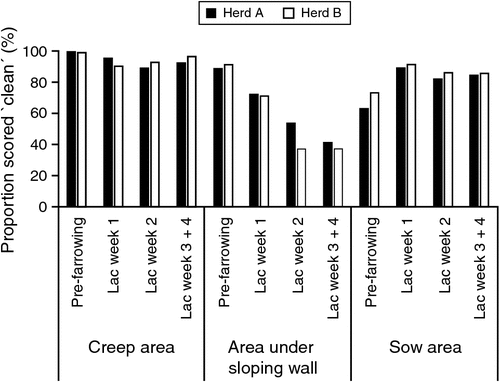Pen hygiene and piglet mortality in farrowing pens with partly solid floor, changes through lactation
J. Hales A C , A. Norval A , M. B. F. Nielsen B and V. A. Moustsen BA Jyden Animal Housing, Bur, Denmark.
B SEGES Pig Research Centre, Copenhagen, Denmark.
C Corresponding author. Email: jhp@jydenbur.dk
Animal Production Science 57(12) 2499-2499 https://doi.org/10.1071/ANv57n12Ab104
Published: 20 November 2017
Commercial viability of free farrowing pens relies on good performance and functionality of the pens. Design recommendations suggest a partly solid floor to provide a comfortable lying area and to accommodate sow nesting behaviour (Baxter et al. 2011). However, dunging behaviour can be difficult to control when sows are loose and maintaining good hygiene on solid areas can require more effort than fully slatted floors. Improving piglet survival can also be labour intensive, but experiences from practice show both performance and hygiene improves as experience with the system grow. The objective of this study was to investigate how hygiene and piglet mortality developed with increasing experience with the system.
The study was conducted over 3 years in two commercial Danish herds, each with 1200 sows, and SWAP (Sow Welfare And Piglet protection) farrowing pens. The pens had 60% and 40% solid concrete floor in Herd A and B, respectively, and cast iron slats. The solid floor was divided into different areas: ‘creep’, ‘sow area’ and ‘area under sloping wall’. Areas were scored for cleanliness (‘clean and dry’, ‘partly dirty’ or ‘soiled’) once a week, and sow cleanliness was assessed (‘clean and dry’, ‘partly dirty’ or ‘dirty’). Cause of death of piglets within herds was recorded (‘weak’, ‘crushed’, ‘starvation/runt’, ‘leg problems’, ‘other’) and Herd A also recorded weekly performance figures. Data on hygiene and performance was analysed for effects of herd, season, time and week in lactation using linear models (SAS v9.4, SAS Institute Inc., Cary, NC, USA). Results showed a decrease in total piglet mortality (stillborn and liveborn deaths of total born) from 26.8% in the first quarter to 22% in the last quarter (P < 0.01) 2 years later. In this period, there was an increase in the number of liveborn piglets/litter (16.5 ± 0.15 v. 17.9 ± 0.15, P < 0.01) and a higher weaned piglets/litter (13.3 ± 0.24 v. 14.2 ± 0.18, P < 0.05), indicating that performance improved over time. Crushing was the main cause of death (P < 0.001) with 58%, 64% and 59% of mortality attributed to crushing in lactation week 1, 2 and 3 + 4, respectively. Cleanliness of the sow area differed between herds (P < 0.001) and seasons (P < 0.001). The proportion of clean sow areas increased after farrowing (P < 0.001) whereas cleanliness of the area under the sloping wall decreased during lactation (P < 0.001) (Fig. 1). Only piglets can defecate under the sloped wall and the reduced cleanliness indicate that piglets developed unwanted dunging behaviour. Sows were cleaner in Herd B compared to Herd A (P < 0.001) but in both herds sow cleanliness decreased through lactation (P < 0.001). In Herd A, 70% of sows were clean before farrowing, decreasing to 55% in lactation week 3 + 4. In Herd B, 96% of sows were clean before farrowing and 87% were clean in week 3 + 4. These results are consistent with the reduced cleanliness of pens and also indicate an effect of the different floor profiles on sow cleanliness.

|
This study indicates that experience with a system improves performance and that the effect of interventions might be improved by aiming specific interventions at specific time points.
References
Baxter EM, Lawrence AB, Edwards SA (2011) Animal 5, 580–600.| Crossref | GoogleScholarGoogle Scholar |
Project supported by the Market Development Fund.


